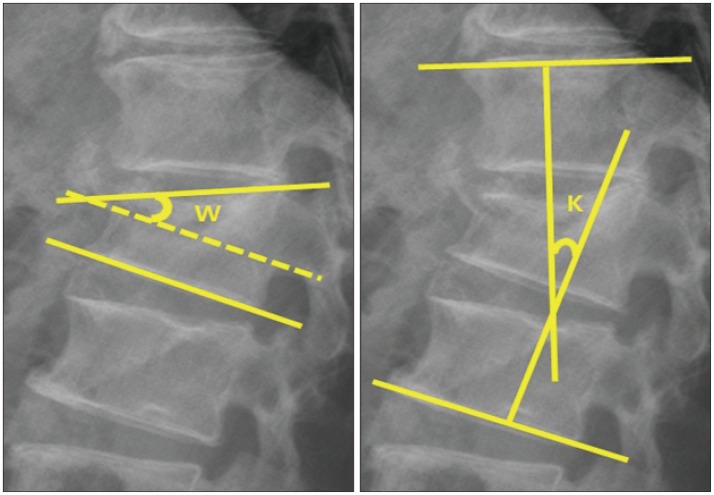Korean J Neurotrauma.
2014 Oct;10(2):86-91. 10.13004/kjnt.2014.10.2.86.
Risk Factors of New Adjacent Compression Fracture after Percutaneous Vertebroplasty: Effectiveness of Bisphosphonate in Osteoporotic or Osteopenic Elderly Patients
- Affiliations
-
- 1Department of Neurosurgery, Dankook University College of Medicine, Cheonan, Korea. spine1225@naver.com
- 2Department of Radiology, Dankook University College of Medicine, Cheonan, Korea.
- KMID: 2256239
- DOI: http://doi.org/10.13004/kjnt.2014.10.2.86
Abstract
OBJECTIVE
The purpose of this study is to investigate the incidence of new compression and to analyze factors that influence the fractures in adjacent levels after percutaneous vertebroplasty (PVP).
METHODS
This retrospective study examined 206 patients who had undergone PVP for single level osteoporotic or osteopenic compression fractures during the last seven years in our department. After PVP, the patients were observed for at least over one year, and 29 patients showed new additional compression fractures in adjacent levels. One hundred seventy seven patients who did not show additional compression fractures were analyzed as the control group. Statistical comparisons were performed between the groups, in terms of age, gender, bone mineral density, whether bisphosphonate (BPP) was treated, preoperative kyphosis, preoperative wedge angle, change in wedge angle, amount of bone cement, existence of intradiscal bone cement leakage, and initial fracture levels.
RESULTS
The statistically significant factors that influence new compression fractures in adjacent levels after PVP were as follows: being female, initial thoracolumbar junction fracture, preoperative large kyphotic, preoperative large wedge angle, change in wedge angle, administration of BPP in osteopenia group, and intradiscal cement leakage.
CONCLUSION
This study identified many factors that influence newly developed compression fractures in adjacent levels after PVP. Interestingly, the administration of BPP in osteopenia group had positive influence on new fractures in this study. Therefore, we recommend early administration of BPP to patients with osteopenia.
Keyword
MeSH Terms
Figure
Reference
-
1. Baumann C, Fuchs H, Kiwit J, Westphalen K, Hierholzer J. Complications in percutaneous vertebroplasty associated with puncture or cement leakage. Cardiovasc Intervent Radiol. 2007; 30:161–168. PMID: 17216377.
Article2. Gangi A, Kastler BA, Dietemann JL. Percutaneous vertebroplasty guided by a combination of CT and fluoroscopy. AJNR Am J Neuroradiol. 1994; 15:83–86. PMID: 8141070.3. Grados F, Depriester C, Cayrolle G, Hardy N, Deramond H, Fardellone P. Long-term observations of vertebral osteoporotic fractures treated by percutaneous vertebroplasty. Rheumatology (Oxford). 2000; 39:1410–1414. PMID: 11136886.
Article4. Komemushi A, Tanigawa N, Kariya S, Kojima H, Shomura Y, Komemushi S, et al. Percutaneous vertebroplasty for osteoporotic compression fracture: multivariate study of predictors of new vertebral body fracture. Cardiovasc Intervent Radiol. 2006; 29:580–585. PMID: 16565797.
Article5. Liebschner MA, Rosenberg WS, Keaveny TM. Effects of bone cement volume and distribution on vertebral stiffness after vertebroplasty. Spine (Phila Pa 1976). 2001; 26:1547–1554. PMID: 11462084.
Article6. Lin CC, Chen IH, Yu TC, Chen A, Yen PS. New symptomatic compression fracture after percutaneous vertebroplasty at the thoracolumbar junction. AJNR Am J Neuroradiol. 2007; 28:1042–1045. PMID: 17569953.
Article7. Lo YP, Chen WJ, Chen LH, Lai PL. New vertebral fracture after vertebroplasty. J Trauma. 2008; 65:1439–1445. PMID: 19077639.
Article8. Mazanec DJ, Podichetty VK, Mompoint A, Potnis A. Vertebral compression fractures: manage aggressively to prevent sequelae. Cleve Clin J Med. 2003; 70:147–156. PMID: 12636346.
Article9. Rho YJ, Choe WJ, Chun YI. Risk factors predicting the new symptomatic vertebral compression fractures after percutaneous vertebroplasty or kyphoplasty. Eur Spine J. 2012; 21:905–911. PMID: 22160212.
Article10. Ross PD, Genant HK, Davis JW, Miller PD, Wasnich RD. Predicting vertebral fracture incidence from prevalent fractures and bone density among non-black, osteoporotic women. Osteoporos Int. 1993; 3:120–126. PMID: 8481587.
Article11. Russell RG, Watts NB, Ebetino FH, Rogers MJ. Mechanisms of action of bisphosphonates: similarities and differences and their potential influence on clinical efficacy. Osteoporos Int. 2008; 19:733–759. PMID: 18214569.
Article12. Schlegel JD, Smith JA, Schleusener RL. Lumbar motion segment pathology adjacent to thoracolumbar, lumbar, and lumbosacral fusions. Spine (Phila Pa 1976). 1996; 21:970–981. PMID: 8726202.
Article13. Syed MI, Patel NA, Jan S, Harron MS, Morar K, Shaikh A. New symptomatic vertebral compression fractures within a year following vertebroplasty in osteoporotic women. AJNR Am J Neuroradiol. 2005; 26:1601–1604. PMID: 15956537.14. Trout AT, Kallmes DF, Kaufmann TJ. New fractures after vertebroplasty: adjacent fractures occur significantly sooner. AJNR Am J Neuroradiol. 2006; 27:217–223. PMID: 16418388.
- Full Text Links
- Actions
-
Cited
- CITED
-
- Close
- Share
- Similar articles
-
- Vertebroplasty in the Multiple Osteoporotic Compression Fracture
- Risk Factors for Subsequent Fracture after Osteoporotic Vertebral Compression Fracture
- Complication of the Augmented Vertebral Body after Percutaneous Vertebroplasty in Patients with Osteoporotic Compression Fracture: Hammer Effect: Preliminary Report
- The Effect of Early Percutaneous Vertebroplasty in Occult Osteoporotic Vertebral Fracture
- Long Term Results of Vertebroplasty in the Treatment of Osteoporotic Compression Fracture


